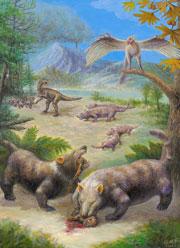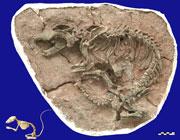 This artist’s impression shows how the metre-long mammals might have looked.© Institute of Vertebrate Paleontology and Paleoanthropology, Chinese Academy of Sciences
This artist’s impression shows how the metre-long mammals might have looked.© Institute of Vertebrate Paleontology and Paleoanthropology, Chinese Academy of SciencesPalaeontologists have dug up a new species of mammal that roamed China during the reign of the dinosaurs. The creature was large enough to feast on young dinosaurs, exploding the myth that all of the mammals living back then were relatively tiny.
Repenomamus giganticus, as the creature has been christened, was more than a metre long, about the size of a large dog. However, it would have more closely resembled a badger, says Yaoming Hu of the American Museum of Natural History in New York, who led the examination of the fossil.
The fossil, which dates back 130 million years and was found in Liaoning in northern China, has a skull that is double the size of that of its closest relative, R. robustus, Hu and his colleagues report in this week's Nature1.
This makes it a startling addition to the ranks of Mesozoic mammals, who lived with the dinosaurs more than 65 million years ago. "We were totally surprised," Hu told news@nature.com. "The idea about Mesozoic mammals is that they were small. These ones are totally different."
Digestible theory
“The idea about Mesozoic mammals is that they were small — these ones are totally different.”
Yaoming Hu
American Museum of Natural History, New York
So big, in fact, was R. giganticus that it may well have had some dinosaurs for breakfast, literally. At the same site, the researchers uncovered a R. robustus skeleton with the bones of a baby Psittacosaurus in just the spot where its stomach would have been.
If R. robustus could manage to eat a dinosaur, then its big brother almost certainly could, Hu and his colleagues suggest. They add, however, that it may well have fed on plants and insects too.
"If this is not the largest Mesozoic mammal, it must be approaching it," comments Jerry Hooker, who studies prehistoric mammals at the Natural History Museum in London. "Its jaw length is about that of a fox."
The idea that Repenomamus ate young dinosaurs is very plausible, he adds. The dinosaur bones found with R. robustus are from a single individual and some are still articulated, making it unlikely that they were washed there from elsewhere after death.
 The skeleton of R. giganticus was found in Liaoning, China.© Institute of Vertebrate Paleontology and Paleoanthropology, Chinese Academy of Sciences
The skeleton of R. giganticus was found in Liaoning, China.© Institute of Vertebrate Paleontology and Paleoanthropology, Chinese Academy of SciencesThe bones' articulation also suggests that Repenomamus tore its prey limb from limb before gulping it down in large chunks, Hooker argues. This theory is bolstered by the fact that the mammals' teeth are sharp, with no molars.
One way to confirm that the Psittacosaurus was eaten would be to look for corrosion on its bones from digestive acids, Hooker suggests. "Mammalian carnivores today have very strong digestive juices," he says. Hyenas' stomach acid, for example, can make holes in bones and teeth.
Hooker rejects the suggestion, however, that Repenomamus supplemented its diet with vegetarian options. "I would have thought it unlikely that they were eating plants," he says. "With these teeth you wouldn't expect them to do a lot of grinding or crushing, and that's what you would need, like a pestle and mortar."
American Museum of Natural History, New York
Natural History Museum, London
-
References
- Hu, Y., Meng, J., Wang, Y. & Li, C. Nature 433, 149−152 (2005). | Article |
